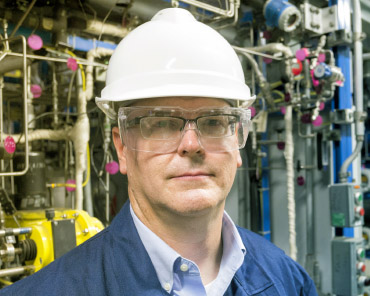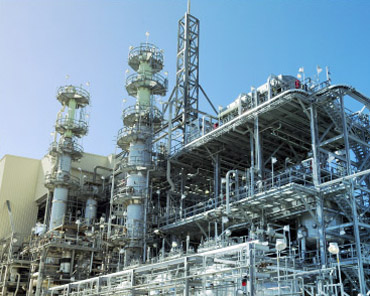Read halfway through this story, and you may just think that it’s about the modern miracle of nylon. Which, we hope you’ll agree, is pretty fascinating in itself.
Yet by the end, you’ll realize it’s really about two intangibles: courage and will.
It’s about the courage to stand up and say “good enough” isn’t always “good enough.” And it’s about having the will to invest millions in doing things in the most environmentally sustainable way possible.
The year 1938 was an inventor’s paradise. New-fangled additions to our culture included the ball-point pen, rubber-soled shoes and photocopying. But perhaps no debut from that watershed year has had a more profound and lasting effect on our way of life than nylon — a polymer that quickly became used in everything from toothbrush bristles to fabrics.
During World War II, nylon production switched from consumer to military applications to help win the war — replacing difficult-to-acquire Asian silk with a plentiful stream of military gear which included everything from parachutes to mosquito netting to tire cords.
Post-war demand for nylon, and in particular, “nylons,” the eponymous women’s stockings, is legend — even spawning riots among throngs of women at American retail stores.

Jerry Grunewald, INVISTA
Over the decades nylon innovations continued — modern athletic shoes and the convenience of carry-on luggage among them.
The early 1970s saw the rapid growth of nylon 6,6 in engineering plastic applications — with better strength and heat resistance. This remarkable nylon is everywhere today, from automobile engine components to guitar tuning pegs.
As with anything, for all of the benefits any technology brings, there are tradeoffs. One of the tradeoffs was that the most advanced nylon 6,6 production process required safe handling of a hazardous by-product called benzene.
Which brings us to 2004, and the acquisition of a major nylon manufacturing business — INVISTA, a Koch company.
Koch and INVISTA were, and are, deeply committed to environmental, health and safety excellence, including reducing, mitigating, and eliminating risks of hazardous chemical emissions and releases.
Jerry Grunewald, INVISTA vice president of R&D and technology, recounts the choices that faced them shortly after the acquisition.
“The easiest, lowest cost thing to do was to safely collect and treat the benzene by-product,” Jerry recalls.
“Yet we asked ourselves, ‘What if there was a better way? What if a new innovation allowed us to not produce benzene in the first place?’”
Truth is, there was such a way. Small scale solutions had proven promising in the chemistry lab. But the challenges to bring them to full-scale production were daunting, and success was by no means certain.
-

Making it Better - Slider image 1
-

Making it Better - Slider image 2
-

Making it Better - Slider image 3
-

Making it Better - Slider image 4
Innovation that benefits both our customers and the planet requires a steadfast commitment. Not to mention the critical investments in people and technology that can make it happen.
Doing so would require significant technical development. Not to mention, vast commitments of time and money. Other challenges loomed, including a major economic downturn that had softened demand for polymers industrywide.
And just when things couldn’t get worse, they did. In 2008 the INVISTA R&D facility in Orange, Texas, where the development would take place, was hammered by Hurricane Ike.
“Even nature seemed aligned against us,” Jerry said.
With a lab that was a flooded mess, and an industry at the bottom of the business cycle, courage and will came into play.
INVISTA and Koch leadership refused to accept the status quo. Instead, they did something bold. They authorized a $30 million R&D program — at the time, the most expensive individual R&D project undertaken by INVISTA — to build and run a pilot plant that would produce nylon 6,6 without benzene with the hope of one day bringing it to full scale production.
The pilot plant started in 2010. And the ups and downs of the development roller coaster began.

Today in Orange, Texas, the INVISTA team has virtually eliminated a hazardous chemical from the nylon 6,6 production process by not even producing it in the first place.
“The team would hit a wall. But where there’s a will, there’s a way.” Jerry said triumphantly, “With a lot of hard work and innovative thought, and a little luck, we succeeded.”

Full-scale production at the Orange, Texas, site started up in December 2014.
Another key reason for success is that Koch and the EPA were both deeply committed to making the new technology work.
“Our leadership and theirs worked cooperatively. We knew it would require close collaboration to be successful,” Jerry explains.
Full-scale production at the Orange, Texas, site started up in December 2014 — with potential plans to take the new technology global at INVISTA factories in Victoria, Texas, a joint venture in Chalampé, France, and a new facility in Shanghai, China.
“In Orange, we’ve virtually eliminated a hazardous chemical from the process by not even producing it in the first place.” Jerry smiles. “The cherry on top is that our yields and energy consumption are better, too. It’s a win for the environment and our communities, as well as our company’s profitability.”
All of which proves that sometimes it’s not just the science of chemistry that you apply to make the world better, but the courage and the will to succeed.